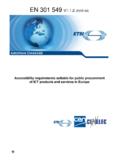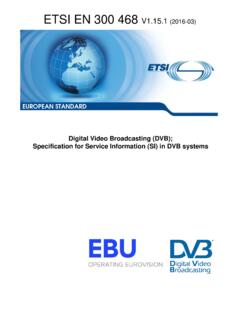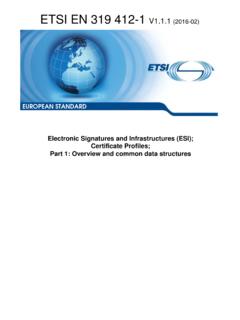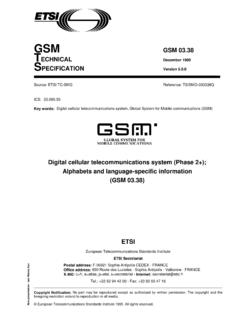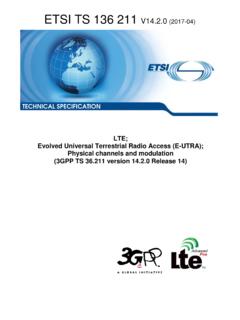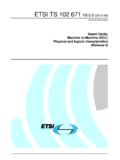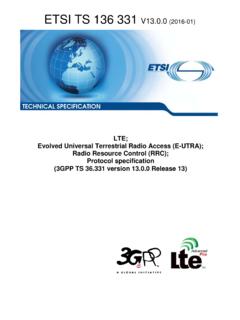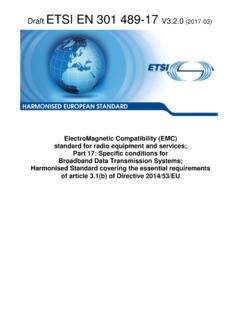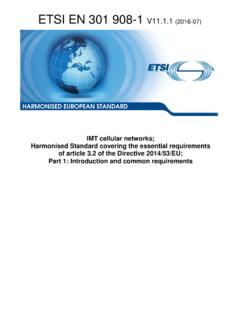Transcription of EUROPEAN ETS 300 019-1-3 …
1 EUROPEAN ETS 300 019-1-3 . TELECOMMUNICATION February 1992. STANDARD. Source:ETSI TC-EE Reference:DE/EE-1019-1-3. ICS: Key words: Environment, test, equipment Equipment Engineering (EE);. Environmental conditions and environmental tests for telecommunications equipment Part 1-3: Classification of environmental conditions Stationary use at weatherprotected locations ETSI. EUROPEAN Telecommunications Standards Institute ETSI Secretariat New presentation - see History box Postal address: F-06921 Sophia Antipolis CEDEX - FRANCE. Office address: 650 Route des Lucioles - Sophia Antipolis - Valbonne - FRANCE. : c=fr, a=atlas, p=etsi, s=secretariat - Internet: Tel.: +33 92 94 42 00 - Fax: +33 93 65 47 16. Copyright Notification: No part may be reproduced except as authorized by written permission. The copyright and the foregoing restriction extend to reproduction in all media. EUROPEAN Telecommunications Standards Institute 1992.
2 All rights reserved. Page 2. ETS 300 019-1-3 : February 1992. Whilst every care has been taken in the preparation and publication of this document, errors in content, typographical or otherwise, may occur. If you have comments concerning its accuracy, please write to "ETSI Editing and Committee Support Dept." at the address shown on the title page. Page 3. ETS 300 019-1-3 : February 1992. Contents Foreword .. 5. 1 Scope .. 7. 2 Normative references .. 7. 3 7. 4 Environmental classes .. 8. Class : Temperature-controlled 8. Class : Partly temperature-controlled locations .. 9. Class : Not temperature-controlled 11. Class : Sites with heat-trap .. 13. Class : Sheltered 14. 5 Environmental 17. Climatic 17. Biological conditions .. 18. Chemically active substances .. 18. Mechanically active substances .. 20. Mechanical 20. History .. 22. Page 4. ETS 300 019-1-3 : February 1992. Blank page Page 5. ETS 300 019-1-3 : February 1992.
3 Foreword This multi-part EUROPEAN Telecommunication Standard (ETS) has been produced by the Equipment Engineering (EE) Technical Committee of the EUROPEAN Telecommunications Standards Institute (ETSI). This standard is concerned with environmental conditions and environmental tests for telecommunications equipment and comprises two main parts, each with subdivisions: - ets 300 019 -1: "Classification of environmental conditions". This part of the standard, Part 1, specifies different standardised environmental classes covering climatic and biological conditions, chemically and mechanically active substances and mechanical conditions during storage, transportation and in use. - ets 300 019 -2: "Specification of environmental tests". This part of the standard will specify the test requirements for the different environmental classes. Each part of the standard is divided into sub-parts. Sub-part 1-0 will form a general overview of Part 1.
4 This sub-part, Sub-part 1-3, deals with stationary use at weatherprotected locations. This part of the standard, (Part 1) was submitted to Public Enquiry as prETS 300 019 Part B. The original Part A is to be published as ETSI Technical Report ETR 035 entitled: "Equipment Engineering (EE);. Environmental engineering Guidance and terminology". Page 6. ETS 300 019-1-3 : February 1992. Blank page Page 7. ETS 300 019-1-3 : February 1992. 1 Scope The purpose of this sub-part is to define the classes of environmental conditions and their severities to which equipment may be exposed at specified locations. The severities specified are those which will have a low probability of being exceeded; generally less than 1 %. This sub-part applies to equipment installed for stationary use at weatherprotected locations during: - normal operation;. - exchange or installation construction;. - repair and maintenance. 2 Normative references This ETS contains, by dated or undated reference, provisions from other publications.
5 These normative references are cited at the appropriate places in the text and the publications listed hereafter. For dated references, subsequent amendments to, or revisions of any of these publications apply to this ETS only when incorporated in it by amendment or revision. For undated references the latest edition of the publication referred to applies. [1] ETR 035: "Equipment Engineering (EE); Environmental engineering Guidance and terminology". [2] IEC Publication 721-3-0 : "Introduction". [3] IEC Publication 721-3-3 : "Stationary use at weatherprotected locations". [4] IEC Publication 68-2-27 : "Test Ea: Shock". 3 Definitions Stationary use: The equipment is mounted firmly on the structure, or on mounting devices, or it is permanently placed at a certain site. It is not intended for portable use - but short periods of handling during erection work, down time, maintenance and repair at the location are included. Weatherprotected location: A location at which the product is protected from weather.
6 - Totally weatherprotected location (enclosed location): direct weather influences are totally excluded, - partly weatherprotected location (sheltered location): direct weather influences are not completely excluded. Climate-controlling system: A system that controls or influences climate, acting at least on one climatic parameter in one direction. Heating system: A system that controls or influences climate by increasing the air temperature only. This can decrease the relative humidity. Cooling system: A system that controls or influences climate by decreasing the air temperature only. This can decrease the absolute humidity. Forced ventilation system: A system that controls or influences climate by introducing outdoor air into the room or expelling air out of the room. Air conditioning system: A system that fully and automatically controls the climatic parameters air temperature and humidity by heating, cooling, humidifying and dehumidifying.
7 Page 8. ETS 300 019-1-3 : February 1992. Relative humidity: The ratio of the partial pressure of the water vapour in moist air at a given temperature t, to the partial pressure of the water vapour in saturated air at the same temperature t. Absolute humidity: The mass of water vapour in grammes which is associated with one cubic metre of dry air in an air/water vapour mixture. 4 Environmental classes The classes shown in parentheses, (3C1), may be selected for special applications. Class : Temperature-controlled locations This class is a combination of classes 3K3/3Z2/3Z4/3B1/3C2(3C1)/3S2/3M1 in IEC standard 721-3-3 [3]. This class applies to a permanently temperature controlled enclosed location. Humidity is usually not controlled. The climatogram is shown in figure 1. Heating, cooling, forced ventilation and humidification are used as necessary to maintain the required conditions - especially where there is a significant difference between the room environment and the external ambient.
8 The climate-controlling systems could be periodically switched on or off but extremely high or low temperatures are prevented. This class applies to locations: - where installed equipment may be exposed to solar radiation and to heat radiation. It may also be exposed to movements of the surrounding air due to draughts in buildings. They are not subjected to condensed water, precipitation, water from sources other than rain or icing;. - without particular risks of biological attacks. This includes protective measures, special product design, or installations at locations of such construction that mould growth and attacks by animals, etc. are not probable;. - with normal levels of contaminants experienced in urban areas with industrial activities scattered over the whole area and/or with heavy traffic;. - without special precautions to minimise the presence of sand or dust, but which are not situated in proximity to sources of sand or dust.
9 - with insignificant vibration and shock. The conditions of this class may be found in: - normal living or working areas, living rooms, rooms for general use (theatres, restaurants);. - offices;. - shops;. - workshops for electronic assemblies and other electrotechnical products;. - telecommunication centres;. - storage rooms for valuable and sensitive products. Page 9. ETS 300 019-1-3 : February 1992. NOTE: Exceptional conditions may occur following the failure of the temperature controlling system. Figure 1: Climatogram for Class : Temperature-controlled locations Class : Partly temperature-controlled locations This class is a combination of classes 3K5/3Z2/3Z4/3B2/3C2(3C1)/3S3/3M2 in IEC standard 721-3-3 [3]. This class applies to an enclosed location having neither temperature nor humidity control. The climatogram is shown in figure 2. Heating may be used to raise low temperatures especially where there is a significant difference between the conditions of this class and the open-air climate.
10 Building construction is designed to avoid extremely high temperatures. This class applies to locations: - where installed equipment may be exposed to solar radiation and heat radiation. They may also be exposed to movements of the surrounding air due to draughts in buildings, through open windows. They may be subjected to condensed water and to water from sources other than rain and icing. They are not subjected to precipitation;. Page 10. ETS 300 019-1-3 : February 1992. - where mould growth or attacks by animals, except termites, may occur;. - with normal levels of contaminants experienced in urban areas with industrial activities scattered over the whole area and/or with heavy traffic;. - in close proximity to sources of sand or dust;. - with vibration of low significance, for products fastened to light supporting structures subjected to negligible vibrations. The conditions of this class may be found in: - entrances and staircases of buildings.
